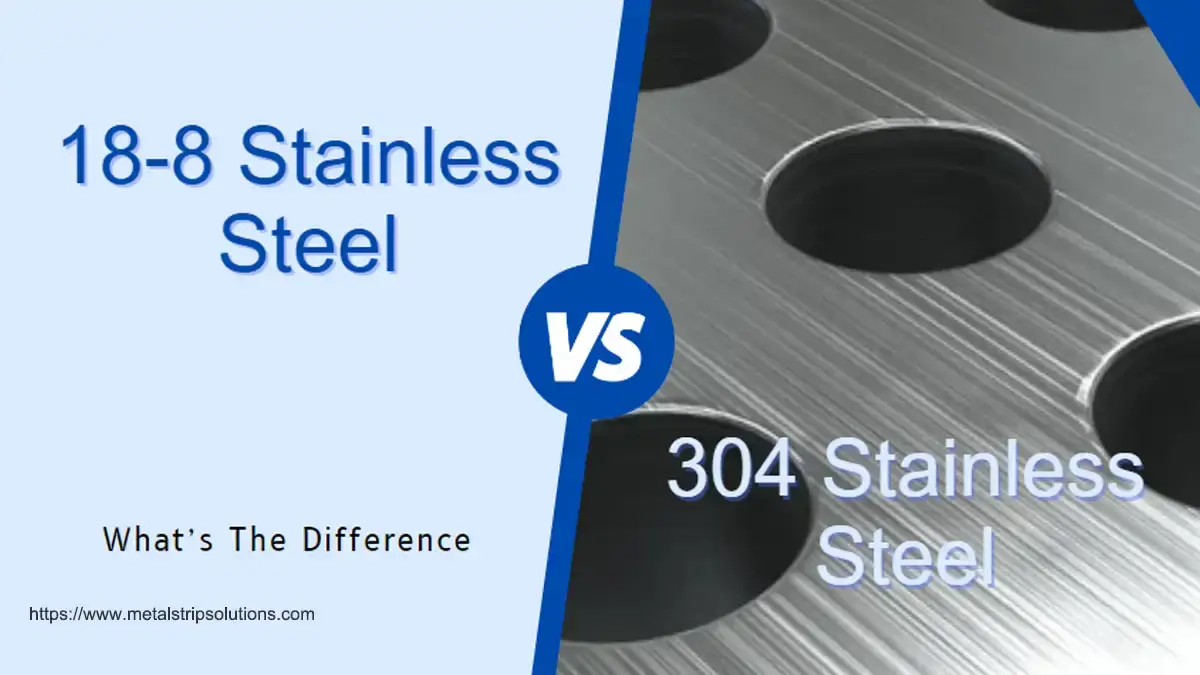The 18-8 is a grade of stainless steel; this name is derived from its chemical composition, meaning this grade has 18% chromium and 8% nickel contents.
On the other hand, 304 stainless steel has 18-20% chromium and 8-10% nickel contents but max 0.07% carbon contents in its composition and belongs to the austenitic stainless steel family.
Grade 304 stainless steel also has several features in common with 18-8 stainless steel, such as resistance to corrosion and oxidation. The presence of carbon gives this alloy greater strength and hardness, distinguishing it from other alloys.
This difference basically refers to the number and grade. For example, the numbers 18-8, 18-10, and 18-0 show the compositions of stainless steel, and grades like 304, 310, 316 show the quality properties like corrosion resistance, durability, and high-temperature resistancee of the specific type of stainless steel.
Let’s discover more if you want to know more about 18-8 and 304 stainless steel grades and their difference.
Let’s keep reading.
What is 18-8 Stainless Steel?
The 18-8 stainless steel belongs to the austenitic family and is the most widely used grade due to its flexibility and ease of work.
The 18-8 numbers show its composition. 18 refers to 18 refers to 18% chromium and 8 for 8% nickel content.
This type of stainless steel has excellent corrosion resistance properties compared to low-carbon steel due to the high percentage of nickel and chromium contents.
18-8 stainless steel is also part of 301 and 302 grades of stainless steel due to the same concentration of chromium and nickel contents.
It is also extremely durable and simple to make. It’s also easy to clean and comes in a variety of colors and finishes.
Austenite steel or 304-grade steel are other names for 18/8 stainless steel.
The higher chromium content of 18/8 steel improves its corrosion resistance as well as other beneficial characteristics.
However, other substances, such as molybdenum, nickel, and nitrogen, may also contribute to this.
What is 304 Stainless Steel?

The 304 stainless steel is austenitic grade steel and is most widely used in applications due to its well-balanced composition, nonmagnetic behavior, and excellent corrosion resistance properties.
This grade has a high-temperature phase and (FCC) face-centered cubic structure due to the austenitic class.
Iron is the primary component of stainless steel. Therefore, grade 304 has 66% to 75% iron content in its composition.
Due to the high concentration of alloying elements in 304 stainless steel, it has substantially lower iron content than other steels.
Additionally, the chromium concentration of 304 stainless steel is 18–20%, and the nickel content is 8–10%.
This grade of stainless steel is mostly preferable for many applications due to its excellent corrosion resistance and ease of welding.
Difference between 304 and 18-8 stainless steel
While considering 304-grade stainless steel, it also belongs to the 300 series and is sometimes referred to as 18-8 stainless steel due to its makeup.
Similar to 18-8 stainless steel, it normally contains 18% chromium and 8% nickel, while the carbon level is typically lower.
Their applications are one of the main distinctions between these two. There are some variations in the composition of 304 and 18/8 stainless steels; therefore, they have slightly different properties and applications. You can say these are closely related but not the preciously same with each other.
Although the two kinds of steel have a number of similarities, 304 stainless steel is more frequently used than 18-8 due to its superior welding skills and higher corrosion resistance.
Corrosion Resistance
Both grades of stainless steel have excellent corrosion resistance properties. The concentration of chromium and nickel are almost the same for these two; therefore, these are very suitable for chemical processing, shipbuilding and food processing applications.
The primary distinction between 304 steel and 18/10 steel is that 304 steel develops a barrier on its surface to ward off corrosion. While 18/10 is missing this type of layer, so it is less resistant to corrosion. Due to the surface composition of 18/10 and 304 steels being different, 18/10 has a shinier look, making it more suitable for decorative uses than 304 steel.
The Grade 304 stainless steel has slightly more nickel content; therefore, it shows better resistance to corrosion in extremely corrosive environments.
Strength
Both stainless steel grades have excellent strength and corrosion resistance according to the requirement of the specific application. The 304 grade of stainless steel has a good tensile strength of about 621 MPa (90 Ksi) with 870˚C maximum operating temperature.
Cost
When we discuss the cost of these two stainless steel grades, the cost of 18/8 is less than the 304 grade. Due to its lower nickel content, 304 stainless steel may be slightly more expensive than 18/8, but this cost difference is often minor for the majority of applications.
Applications
Application of 18-8 stainless steel:
Due to the good concentration of chromium and nickel, this type of steel is commonly used in many applications like:
Cutlery, kitchenware,
Food-processing machinery,
Pressure pipelines and vessels, wheel covers, storage tanks, structural elements for the aerospace and automotive industries, and highly corrosive situations.
Applications of 304 stainless steel:
The 304 stainless steel is very suitable for domestic and commercial applications. It is most frequently used in food processing equipment, railing & trim, heat exchangers, architectural paneling, threaded fasteners, kitchen equipment, springs, and braces. This type of stainless steel is also suitable for marine equipment and industrial applications.
Conclusion
Overall, 18-8 and 304 stainless steels have an important place in the industry due to their outstanding corrosion resistance, durability strength and high-temperature resistance properties.
In summary, the difference is only due to the chemical makeup.
The 18/8 stainless steel shows exact chromium and nickel concentrations of 18% and 8%, respectively.
On the other hand, the 304 grade of stainless steel has the ranges of chromium and nickel contents. The chromium ranges from 18% to 20%, and nickel ranges from 8% to 10%. That is the main reason why these stainless steel grades have different properties and applications.
HZW closely follows the pace of the times, innovation is the force that drives HZW to make improvement constantly. We use world-leading equipment and advanced technology, and continuously streamline our production process, aiming to provide customers with the best stainless steel strips products.
Contact us today for your project!












